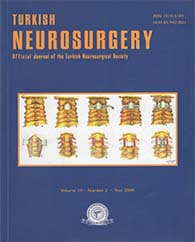MATERIAL and METHOD: Twenty cases that have been operated in our clinic due to G1 and G2 ISL between February 2003 and December 2006 were clinically and radiologically examined. The clinical assessment of the patients was carried out with the Prolo Economic and Functional scale.
RESULTS: Both interbody fusion and laminoplasty procedures concerning 88 pedicles in total were performed on 20 cases of which 10 were at the L4-5 level, whereas 6 were at the L5-S1 level and 2 were at the L3-4-5 level. Five (25%) cases also had coexisting spinal stenosis. 19 (95%) patients had solid fusion but one (5%) had no solid fusion formation while having posterior fusion along with a clinical neurological examination result similar to the one obtained during the preoperative period. In conclusion, the anterior fusion rate was 95%. The most remarkable finding among the patients was the recovery observed at the 2nd month. The Prolo scale results of the cases were good and the follow-up time was 23.5 months.
CONCLUSION: The laminoplasty technique is a method which presents advantages in isthmic spondylolisthesis cases such as short duration of operation, absence of graft donor site complications, preservation of the osteoligamentous structures of the posterior column and a high probability of achievement of fusion through only a posterior approach at a single session; therefore, we believe it is an alternative surgical technique.
Keywords : Laminoplasty, Lumbar spine, Isthmic spondylolisthesis, Spondylolysis




